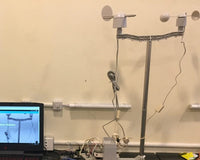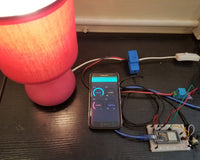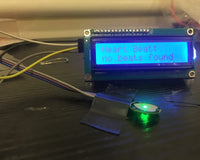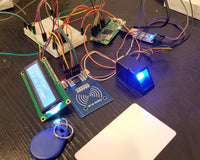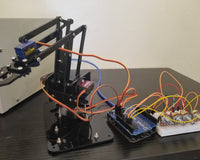Overview
Finally, We integrate all the three sensors into a one working mini-wearable project.
Hardware Used
Software Used
Libraries Used
The libraries used will be the compilation of the previous libraries.
- SPI.h
- Wire.h
- PulseSensorPlayground
- Adafruit_GFX.h
- Adafruit_SSD1306.h
Application Description
To make this a mini-wearable project, we will switch from Uno R3 to a Nano. The components will work with 3.3V.
Set-up the Hardware

Code
#include <SPI.h>
#include <Wire.h>
#include <Adafruit_GFX.h>
#include <Adafruit_SSD1306.h>
#include <PulseSensorPlayground.h>
//PulseSensor
#define USE_ARDUINO_INTERRUPTS true // Set-up low-level interrupts for most accurate BPM math.
//OLED Display
#define OLED_RESET 4
Adafruit_SSD1306 display(OLED_RESET);
#if (SSD1306_LCDHEIGHT != 32)
#error("Height incorrect, please fix Adafruit_SSD1306.h!");
#endif
//Accelerometer
#define DEVICE (0x53) //ADXL345 device address
#define TO_READ (6) //num of bytes we are going to read each time (two bytes for each axis)
#define offsetX -10.5 // OFFSET values
#define offsetY -2.5
#define offsetZ -4.5
#define gainX 257.5 // GAIN factors
#define gainY 254.5
#define gainZ 248.5
//Pulse Sensor Variables
PulseSensorPlayground pulseSensor; // Creates an instance of the PulseSensorPlayground object called "pulseSensor"
const int PulseWire = 0; // PulseSensor Analog WIRE connected to ANALOG PIN 0
int Threshold = 385; // Determine which Signal to "count as a beat" and which to ignore.
// Use the "Gettting Started Project" to fine-tune Threshold Value beyond default setting.
// Otherwise leave the default "550" value.
//Accelerometer Variables
byte buff[TO_READ] ; //6 bytes buffer for saving data read from the device
char str[512]; //string buffer to transform data before sending it to the serial port
int x,y,z, stepsStepped;
int xavg, yavg,zavg, steps=0, flag=0;
int xval[15]={0}, yval[15]={0}, zval[15]={0};
int threshhold = 60.0;
void setup() {
Serial.begin(9600);
Wire.begin();
display.begin(SSD1306_SWITCHCAPVCC, 0x3C); // initialize with the I2C addr 0x3C (for the 128x32)
pulseSensor.analogInput(PulseWire);
pulseSensor.setThreshold(Threshold);
// init done
//Turning on the ADXL345
writeTo(DEVICE, 0x2D, 0);
writeTo(DEVICE, 0x2D, 16);
writeTo(DEVICE, 0x2D, 8);
if (pulseSensor.begin()) {
Serial.println("Pulse Sensor Initialized..."); //This prints one time at Arduino power-up, or on Arduino reset.
}
// Show image buffer on the display hardware.
// Since the buffer is intialized with an Adafruit splashscreen
// internally, this will display the splashscreen.
display.display();
delay(2000);
// Clear the buffer.
display.clearDisplay();
}
void loop() {
int regAddress = 0x32; //First axis-acceleration-data register on the ADXL345
readFrom(DEVICE, regAddress, TO_READ, buff); //read the acceleration data from the ADXL345
int myBPM = pulseSensor.getBeatsPerMinute(); // Calls function on our pulseSensor object that returns BPM as an "int".
// "myBPM" hold this BPM value now.
//each axis reading comes in 10 bit resolution, ie 2 bytes. Least Significat Byte first!!
//thus we are converting both bytes in to one int
x = (((int)buff[1]) << 8) | buff[0];
y = (((int)buff[3])<< 8) | buff[2];
z = (((int)buff[5]) << 8) | buff[4];
stepsStepped = ArduinoPedometer();
if (pulseSensor.sawStartOfBeat()) { // Constantly test to see if "a beat happened".
display.setTextSize(1.2);
display.setTextColor(WHITE);
display.setCursor(0,0);
display.println("Your BPM is: " + String(myBPM) );
display.setCursor(0,10);
display.println("You # Of steps are: " + String(stepsStepped));
display.display();
display.clearDisplay();
}
delay(100);
}
//---------------- Functions
//Writes val to address register on device
void writeTo(int device, byte address, byte val) {
Wire.beginTransmission(device); //start transmission to device
Wire.write(address); // send register address
Wire.write(val); // send value to write
Wire.endTransmission(); //end transmission
}
//reads num bytes starting from address register on device in to buff array
void readFrom(int device, byte address, int num, byte buff[]) {
Wire.beginTransmission(device); //start transmission to device
Wire.write(address); //sends address to read from
Wire.endTransmission(); //end transmission
Wire.beginTransmission(device); //start transmission to device
Wire.requestFrom(device, num); // request 6 bytes from device
int i = 0;
while(Wire.available()) //device may send less than requested (abnormal)
{
buff[i] = Wire.read(); // receive a byte
i++;
}
Wire.endTransmission(); //end transmission
}
//Get pedometer.
int ArduinoPedometer(){
int acc=0;
int totvect[15]={0};
int totave[15]={0};
int xaccl[15]={0};
int yaccl[15]={0};
int zaccl[15]={0};
for (int i=0;i<15;i++)
{
xaccl[i]= x;
delay(1);
yaccl[i]= y;
delay(1);
zaccl[i]= z;
delay(1);
totvect[i] = sqrt(((xaccl[i]-xavg)* (xaccl[i]-xavg))+ ((yaccl[i] - yavg)*(yaccl[i] - yavg)) + ((zval[i] - zavg)*(zval[i] - zavg)));
totave[i] = (totvect[i] + totvect[i-1]) / 2 ;
delay(150);
//cal steps
if (totave[i]>threshhold && flag==0)
{
steps=steps+1;
flag=1;
}
else if (totave[i] > threshhold && flag==1)
{
//do nothing
}
if (totave[i] <threshhold && flag==1)
{
flag=0;
}
// Serial.print("steps=");
// Serial.println(steps);
return(steps);
}
delay(100);
}
Conclusion
Reference
https://create.arduino.cc/projecthub?category=wearables-health-fitness&sort=updated
The post (4/4) BPM (Pulse Sensor) and Pedometer (ADXL345 Accelerometer) Wearable Device with OLED Display appeared first on CreateLabz.



